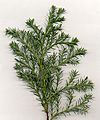| Chamaecyparis pisifera | |
|---|---|

| |
| Chamaecyparis pisifera Morton Arboretum acc. 745-27*4 | |
| Conservation status | |
 Least Concern (IUCN 3.1) | |
| Scientific classification | |
| Kingdom: | Plantae |
| Clade: | Tracheophytes |
| Clade: | Gymnospermae |
| Division: | Pinophyta |
| Class: | Pinopsida |
| Order: | Cupressales |
| Family: | Cupressaceae |
| Genus: | Chamaecyparis |
| Species: | C. pisifera |
| Binomial name | |
| Chamaecyparis pisifera (Siebold & Zucc.) Endl. | |
Chamaecyparis pisifera (Sawara cypress or Sawara Japanese: サワラ, romanized: Sawara) is a species of false cypress, native to central and southern Japan, on the islands of Honshū and Kyūshū.
Description
It is a slow-growing coniferous tree growing to 35–50 m tall with a trunk up to 2 m in diameter. The bark is red-brown, vertically fissured and with a stringy texture. The foliage is arranged in flat sprays; adult leaves are scale-like, 1.5–2 mm long, with pointed tips (unlike the blunt tips of the leaves of the related Chamaecyparis obtusa (hinoki cypress), green above, green below with a white stomatal band at the base of each scale-leaf; they are arranged in opposite decussate pairs on the shoots. The juvenile leaves, found on young seedlings, are needle-like, 4–8 mm long, soft and glaucous bluish-green. The cones are globose, 4–8 mm diameter, with 6–10 scales arranged in opposite pairs, maturing in autumn about 7–8 months after pollination.
Related species
A related cypress found on Taiwan, Chamaecyparis formosensis (Formosan cypress), differs in longer ovoid cones 6–10 mm long with 10–16 scales. The extinct Eocene species Chamaecyparis eureka, known from fossils found on Axel Heiberg Island in Canada, is noted to be very similar to C. pisifera.
Name
The Latin specific epithet pisifera, "pea-bearing", refers to the small round green cones.
Uses
Timber
It is grown for its timber in Japan, where it is used as a material for building palaces, temples, shrines and baths, and making coffins, though less valued than the timber of C. obtusa. The wood is lemon-scented and light-colored with a rich, straight grain, and is rot resistant.
Ornamental
It is also a popular ornamental tree in parks and gardens, both in Japan and elsewhere in temperate climates including western and central Europe and parts of North America. A large number of cultivars have been selected for garden planting, including dwarf forms, forms with yellow or blue-green leaves, and forms retaining the juvenile needle-like foliage; particularly popular juvenile foliage cultivars include 'Plumosa', 'Squarrosa' and 'Boulevard'.
In cultivation in the UK the following have gained the Royal Horticultural Society's Award of Garden Merit (confirmed 2017):
- 'Boulevard': 8 m (26 ft), blue-green foliage
- 'Filifera Aurea': rounded, needle-like golden foliage, to 12 m (39 ft)
- 'Plumosa Compressa': dwarf to 90 cm (35 in), soft mossy foliage on young plants
- 'Sungold': rounded shrub to 3 m (9.8 ft) tall and wide, with needle-like lime green foliage
-
 Grove of 80-year-old trees
Grove of 80-year-old trees
-
 Foliage and cones
Foliage and cones
-
 Central trunk of a tree
Central trunk of a tree
-
 Bark
Bark
-
 Path in the Togakushi Shrine lined with C. pisifera
Path in the Togakushi Shrine lined with C. pisifera
-
Bonsai example
-
 Foliage of the juvenile cultivar 'Boulevard', with soft feathery needle-like leaves
Foliage of the juvenile cultivar 'Boulevard', with soft feathery needle-like leaves
-
Cultivar 'Golden Charm'
-
 Cultivar 'Filifera aurea'
Cultivar 'Filifera aurea'
-
 Leaves of the Filifera aurea
Leaves of the Filifera aurea
-
 Cultivar 'Sungold'
Cultivar 'Sungold'
References
- ^ Farjon, A. (2013). "Chamaecyparis pisifera". IUCN Red List of Threatened Species. 2013: e.T42213A2962099. doi:10.2305/IUCN.UK.2013-1.RLTS.T42213A2962099.en. Retrieved 11 November 2021.
- ^ Farjon, A. (2005). Monograph of Cupressaceae and Sciadopitys. Royal Botanic Gardens, Kew. ISBN 1-84246-068-4
- Kotyk, M.E.A.; Basinger, J.F.; McIlver, E.E. (2003). "Early Tertiary Chamaecyparis Spach from Axel Heiberg Island, Canadian High Arctic". Canadian Journal of Botany. 81 (2): 113–130. doi:10.1139/B03-007.
- Harrison, Lorraine (2012). RHS Latin for Gardeners. United Kingdom: Mitchell Beazley. ISBN 978-1845337315.
- ^ Dallimore, W., & Jackson, A. B. (1966). A Handbook of Coniferae and Ginkgoaceae 4th ed. Arnold.
- "RHS Plantfinder -".
{{cite web}}: Missing or empty|url=(help) - "AGM Plants - Ornamental" (PDF). Royal Horticultural Society. July 2017. p. 16. Retrieved 24 January 2018.
- "RHS Plantfinder - Chamaecyparis pisifera 'Boulevard'". Retrieved 30 January 2018.
- "RHS Plantfinder - Chamaecyparis pisifera 'Filifera Aurea'". Retrieved 30 January 2018.
- "RHS Plantfinder - Chamaecyparis pisifera 'Plumosa Compressa'". Retrieved 30 January 2018.
- "RHS Plantfinder - Chamaecyparis pisifera 'Sungold'". Retrieved 30 January 2018.
External links
| Taxon identifiers | |
|---|---|
| Chamaecyparis pisifera |
|
| Retinospora pisifera | |
- IUCN Red List least concern species
- Chamaecyparis
- Endemic flora of Japan
- Trees of Japan
- Five sacred trees of Kiso
- Least concern biota of Asia
- Least concern plants
- Garden plants of Asia
- Plants used in bonsai
- Ornamental trees
- Plants described in 1844
- Taxa named by Philipp Franz von Siebold
- Taxa named by Joseph Gerhard Zuccarini